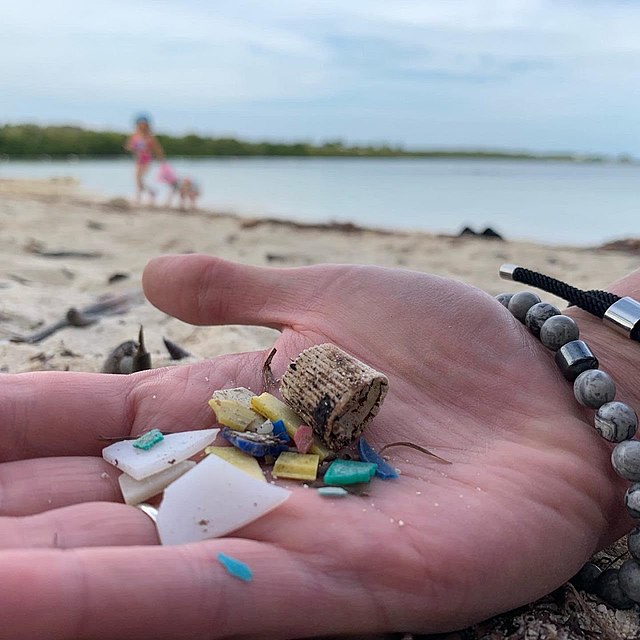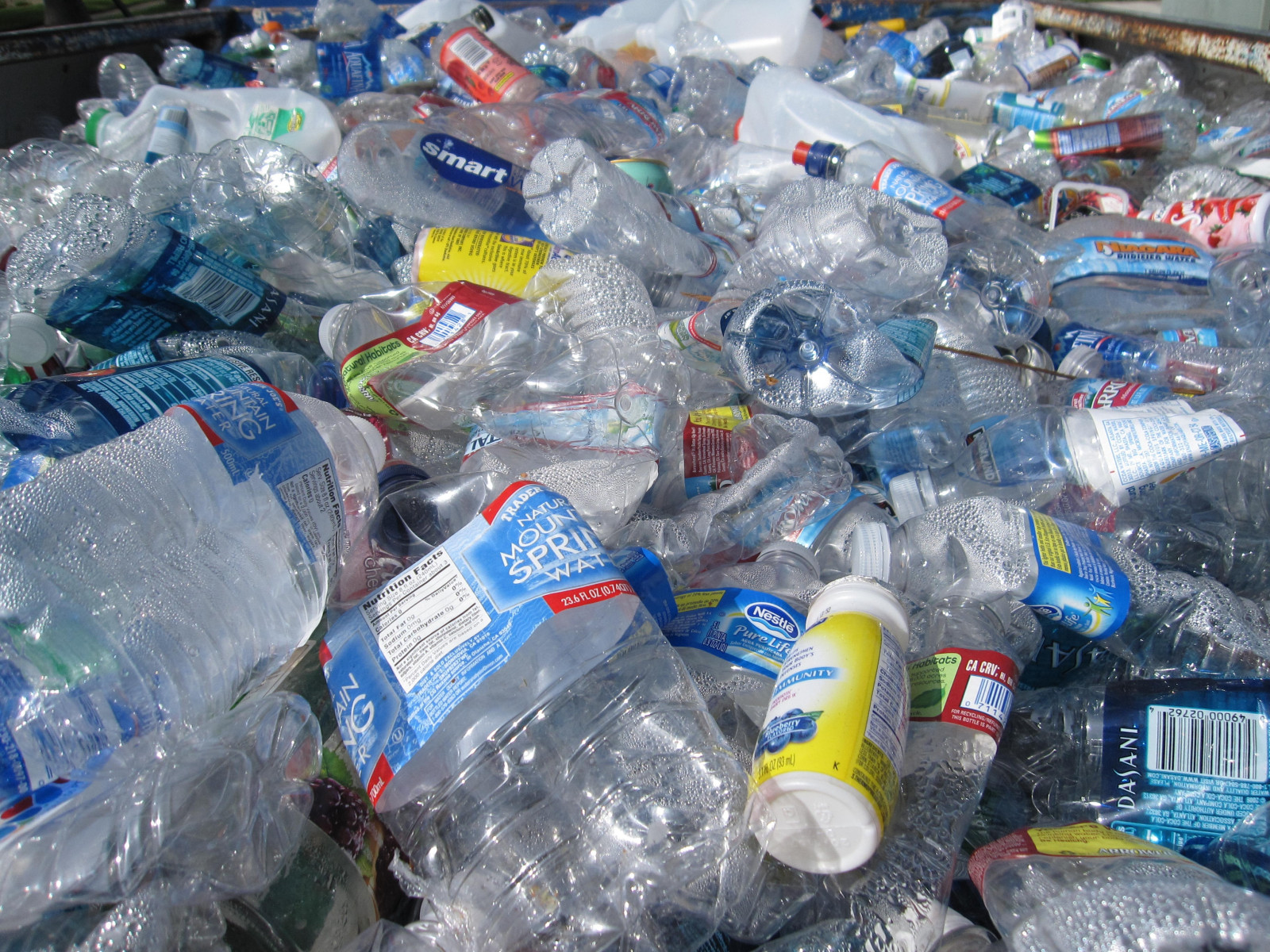
Plastics such as these can be found littering beaches across the world, a visible reminder of the destruction left in the wake of human progress. (Ocean Blue Project/CC BY-SA 4.0)

Plastics such as these can be found littering beaches across the world, a visible reminder of the destruction left in the wake of human progress. (Ocean Blue Project/CC BY-SA 4.0)
Although plastic pollution, the accumulation of plastic waste in our environment, is a relatively new issue, it is one that will persist for centuries, according to Sharon George, research chair at Keele University, focusing on green technology and environmental sustainability. Manufacturers have produced one ton of plastic for every person born after the 1950s, while less than one-tenth has been recycled. George added that as this waste breaks down in the environment, it deteriorates into microplastic particles that are integrated into our food chain and biosphere. To combat this growing problem, further research is necessary.
This research must include the entry of plastics into the environment, human behavior surrounding plastic, Indigenous perspectives on this issue, and viable biodegradable alternatives to synthetic plastics. Regarding market regulations needed to tackle plastic pollution, Life Cycle Analyses (LCAs) must be required, while non-essential single-use plastic products and virgin plastics need to be taxed to incentivize the development and production of biodegradable plastics. Waste management is another arena in which there is much room for improvement to limit plastic pollution, including improving waste tracking, enforcing recycling rules, implementing a national buy-back recycling program, and holding companies accountable for their waste.
There are also many proposed and existing efforts in combating plastic pollution such as the passing of the Break Free From Plastic Pollution Act of 2021, and the Environmental Protection Agency’s (EPA) WasteWise program that promotes the use of sustainable materials at the business and organizational level. However both of these programs can be improved and more can be done, such as including more scientists in the WasteWise program and advancing sustainable policy recommendations in Congress.
Humans have been making and consuming plastics for almost 100 years, as this material’s light weight, low price, and versatility allowed it to gain traction. In 2018, approximately 238 thousand blue whales’ worth of plastic, or 35.7 million tons, were generated in the United States, with 77%, ending up in landfills. Key factors contributing to the issue of mass plastic production and pollution include multinational consumer goods companies and governments in developed countries. According to a report by Tearfund and other organizations, multinational consumer goods companies, such as Coca-Cola, are the primary drivers of single-use plastic production and pollution, and exhibit minimal efforts to manage their waste post-consumption.
The report authors continue to describe the governments in developed countries as also contributing to the issue of plastic waste through the allocation of subsidies, particularly for fossil fuel industries, and the take-make-dispose model of economic development. On top of this, the report states that “Many developed country governments have not done enough to date (for example in the form of bans, regulations and laws) to combat the problem of plastic pollution.”
George explained that the most common material in day-to-day life has come to be disposable plastics, which once broken down into microplastics, make their way into our groundwater, air, and our food through the consumption of meat and fish. There are no easy means of microplastic removal, George said, and decomposition takes hundreds to thousands of years. Plastic production and pollution also exacerbate climate change as global production of this material emits 400 million tons of greenhouse gasses annually.
The EPA’s National Recycling Strategy is one of the recent efforts to combat plastic pollution, although efforts in implementing the Sustainable Materials and Management (SMM) approach, and the Resource Conservation and Recovery Act (RCRA) continue to be underway. Other efforts include the aforementioned WasteWise Program, the Plastics Innovation Challenge, and the United States Department of Agriculture’s (USDA’s) support of research and development of bioplastics.

Promising solutions for the reduction of plastic pollution include tracking and managing waste while reducing production. Mismanaged waste is a primary source of plastic pollution that can be reduced by an Integrated Waste Management System, including improvements in the life-cycle of synthetic plastics. The 2022 National Academies of Sciences, Engineering, and Medicine (NASEM) report stated the U.S. must establish a strategy to limit plastic waste in oceans, and this includes improved waste management. This is a responsibility that must be undertaken considering the U.S. is the highest global contributor of plastic waste. Enhancing the convenience of waste management on behalf of consumers is productive in limiting plastic pollution, as buy-back programs where consumers are compensated for adequate waste disposal decrease littering in the United States.
Although clean-up activities have been common mitigation efforts, they are inadequate in addressing the issue, as plastic in the environment comes in all sizes which inhibits individuals’ abilities to dispose of them. Additionally, sanctions on littering and other forms of problematic waste management have been shown to be ineffective as they require more monitoring than is feasible. However, sanctions can be made successful by being coupled with positive reinforcements such as buy-back programs, and tax incentives for handling plastic waste properly. These solutions enhance recycling rates, which has the potential to offset the difficulties associated with recycling synthetic plastics.
Options for source reduction include improving the designs of plastic products to extend their lives and improve their recyclability, using alternative materials including those that are biodegradable or recycled, and banning the most pervasive kinds of single-use plastic. Recyclability can be improved by reducing the quantities of additives and polymers during production. An example of improvements in design can consist of making components of recyclable products, such as water bottles and caps inseparable.
Incorporating alternative materials is achieved by implementing mandatory minimum percentages of recyclable or biodegradable materials included in products, as well as marketing strategies aimed at shifting consumer preferences toward sustainability. Bans on single-use plastic products have also been successful, exhibited by the reduction in microbeads both in landfills and the environment after they were banned in the U.S., U.K., New Zealand, and Canada. Marketing strategies to guide consumers toward more sustainable choices include labeling plastics such as polystyrene, polyurethane, etc., as hazardous.
Companies can strive to reduce waste and excess production through both mandatory and voluntary measures. Examples of voluntary measures termed corporate social responsibility (CSR) include the EU’s catalog of recommended plastic additives, as well as Operation Clean Sweep which targeted reducing the loss of pre-production plastic pellets. Examples of mandatory measures include the National Pollutant Discharge Elimination System in California, and Canada’s goal to eliminate single-use plastic by 2021. Command and control policies including bans, advertising restrictions, and regulation of consumption can effectively complement CSR to enhance accountability.
An increase in consumer demand for sustainable, plastic-free products would incentivize companies to partake in redesign, although more research is needed regarding the specifics of those alternative designs. Many consumers have been successfully made aware of the importance of sustainable consumption through popular media programs, free online courses, and a growing interest in lectures and activities surrounding sustainability. Popular media has a considerable ability to enhance awareness of the issue and is most successful when emphasizing necessary long-term behavioral changes, such as sustainable purchasing practices and recycling.
Life cycle assessments (LCAs) are a powerful tool for identifying the long-term effects of synthetic materials. LCAs thus far have resulted in the identification of eco-design improvements such as enhancing the durability and thus the reusability and recyclability of packaging materials and prioritizing materials that are less energy-intensive. LCAs have also already demonstrated that plastics are only favorable over alternatives such as aluminum and glass in areas that utilize non-renewable energy sources and have low-recycling rates.
More education regarding the terms ‘degradable’, ‘bio-based’, and ‘biodegradable’ is necessary as these terms are frequently misused by producers and misinterpreted by consumers. Bioplastics, or bio-based polymers, come from renewable feedstocks such as biomass, and importantly are not always biodegradable, as exhibited by bio-polyethylene. On the other hand, Biodegradable plastics include polymers or additives that will break down through composting. However, some synthetic plastics can also be degraded through exposure to plastic-degrading organisms such as Zalerion maritimum.
Although most plastics are made from synthetic polymers, many natural polymers exist as they are produced through biochemical reactions in microorganisms, plants, and animals. These biopolymers are prospective alternative materials, as George explained the most sustainable options for plastics include those that can be produced using sustainably grown non-food crops that can be easily composted. Many “compostable” plastics only break down through commercial composting, which everyday consumers have difficulty accessing, said George. She continued on to say that bioplastics have the potential to be a solution, however, they must be easily biodegradable and their production must become more efficient and viable in order to compete with the cost-effective nature of conventional plastic production.
Requiring LCA’s for all plastic products would improve the production of sustainable products as the indirect and direct environmental, economic, and social impacts of each would be assessed. Taxing non-essential single-use plastic products and virgin plastics is also a means of addressing the material’s production and subsequent waste. Currently, according to George, there is a need for stemming the over-production of plastic products, given that with the low cost and easy production, there is no present incentive for companies to stop over-producing these products. Taxation would serve to increase consumer demand for recycled plastic products, strengthening the circularity of plastic materials, which George said is critical in addressing this issue. Funding the development and production of biodegradable plastics is also a critical step, as these new sustainable products can be integrated into the market through mass accessibility, and maximum positive changes in the product with limited behavioral changes.
In order to improve the management of plastics, the government must fund improved tracking of waste plastic and hold companies responsible for what happens to their waste. George emphasized that there is a need for improved tracking of waste plastic in an effort to stop illegal transport and disposal by ensuring adequate processing. Holding companies fiscally responsible for their waste would serve to reduce the amount of waste produced. Better enforcement of existing legislation surrounding plastic waste management is necessary. Enforcement of recycling rules and incentivizing good practices will ensure that recycled plastic streams have value, which will help increase the rate of circulation and limit the quantity of plastic waste, George said. This would incentivize and increase the effectiveness of recycling.
Passing the Break Free From Plastic Pollution Act of 2021 would result in holding companies accountable for adequately handling their waste following consumer use, while establishing minimum standards for reuse, recycling, and composting rates, as well as phasing out several kinds of single-use plastic products, and limiting the production of single-use products through taxes and buy-backs. This would also mean a temporary permit moratorium placed on some plastic manufacturing facilities until their pollution is regulated in addition to applying limitations on the export of their waste. It would also require the EPA to provide guidelines to standardize waste labeling.
Including scientists in the WasteWise Program is another critical improvement of existing efforts in addressing plastic waste. This program currently fosters partnerships between the EPA and governments, businesses, and non-profit organizations. Although businesses and non-profit organizations may elect to include scientists, the presence of scientists should be explicit as these partnerships inform waste management and the incorporation of sustainable materials.
Thanks to scientists like Sharon George, it is clear that major components attributing to the disconnect between science and policymakers include a lack of urgency and communication. Supporting scientists in communicating their research and responding to their results with urgency is crucial in enhancing this connection and aligning policy with science. Policymakers also must direct scientists regarding what information still needs to be gathered in order to implement effective policy.